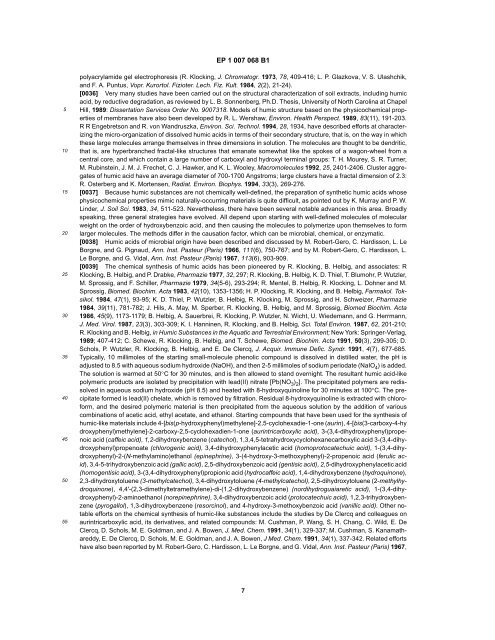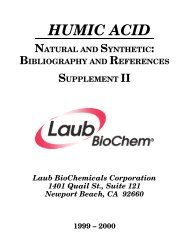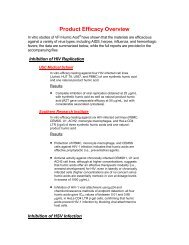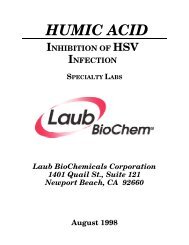HUMIC ACID - Laub BioChem
HUMIC ACID - Laub BioChem
HUMIC ACID - Laub BioChem
- No tags were found...
Create successful ePaper yourself
Turn your PDF publications into a flip-book with our unique Google optimized e-Paper software.
EP 1 007 068 B1510152025303540455055polyacrylamide gel electrophoresis (R. Klocking, J. Chromatogr. 1973, 78, 409-416; L. P. Glazkova, V. S. Ulashchik,and F. A. Puntus, Vopr. Kurortol. Fizioter. Lech. Fiz. Kult. 1984, 2(2), 21-24).[0036] Very many studies have been carried out on the structural characterization of soil extracts, including humicacid, by reductive degradation, as reviewed by L. B. Sonnenberg, Ph.D. Thesis, University of North Carolina at ChapelHill, 1989: Dissertation Services Order No. 9007318. Models of humic structure based on the physicochemical propertiesof membranes have also been developed by R. L. Wershaw, Environ. Health Perspect. 1989, 83(11), 191-203.RREngebretson and R. von Wandruszka, Environ. Sci. Technol. 1994, 28, 1934, have described efforts at characterizingthe micro-organization of dissolved humic acids in terms of their secondary structure, that is, on the way in whichthese large molecules arrange themselves in three dimensions in solution. The molecules are thought to be dendritic,that is, are hyperbranched fractal-like structures that emanate somewhat like the spokes of a wagon-wheel from acentral core, and which contain a large number of carboxyl and hydroxyl terminal groups: T. H. Mourey, S. R. Turner,M. Rubinstein, J. M. J. Frechet, C. J. Hawker, and K. L. Wooley, Macromolecules 1992, 25, 2401-2406. Cluster aggregatesof humic acid have an average diameter of 700-1700 Angstroms; large clusters have a fractal dimension of 2.3:R. Osterberg and K. Mortensen, Radiat. Environ. Biophys. 1994, 33(3), 269-276.[0037] Because humic substances are not chemically well-defined, the preparation of synthetic humic acids whosephysicochemical properties mimic naturally-occurring materials is quite difficult, as pointed out by K. Murray and P. W.Linder, J. Soil Sci. 1983, 34, 511-523. Nevertheless, there have been several notable advances in this area. Broadlyspeaking, three general strategies have evolved. All depend upon starting with well-defined molecules of molecularweight on the order of hydroxybenzoic acid, and then causing the molecules to polymerize upon themselves to formlarger molecules. The methods differ in the causation factor, which can be microbial, chemical, or enzymatic.[0038] Humic acids of microbial origin have been described and discussed by M. Robert-Gero, C. Hardisson, L. LeBorgne, and G. Pignaud, Ann. Inst. Pasteur (Paris) 1966, 111(6), 750-767; and by M. Robert-Gero, C. Hardisson, L.Le Borgne, and G. Vidal, Ann. Inst. Pasteur (Paris) 1967, 113(6), 903-909.[0039] The chemical synthesis of humic acids has been pioneered by R. Klocking, B. Helbig, and associates: RKlocking, B. Helbig, and P. Drabke, Pharmazie 1977, 32, 297; R. Klocking, B. Helbig, K. D. Thiel, T. Blumohr, P. Wutzler,M. Sprossig, and F. Schiller, Pharmazie 1979, 34(5-6), 293-294; R. Mentel, B. Helbig, R. Klocking, L. Dohner and M.Sprossig, Biomed. Biochim. Acta 1983, 42(10), 1353-1356; H. P. Klocking, R. Klocking, and B. Helbig, Farmakol. Toksikol.1984, 47(1), 93-95; K. D. Thiel, P. Wutzler, B. Helbig, R. Klocking, M. Sprossig, and H. Schweizer, Pharmazie1984, 39(11), 781-782; J. Hils, A. May, M. Sperber, R. Klocking, B. Helbig, and M. Sprossig, Biomed Biochim. Acta1986, 45(9), 1173-1179; B. Helbig, A. Sauerbrei, R. Klocking, P. Wutzler, N. Wicht, U. Wiedemann, and G. Herrmann,J. Med. Virol. 1987, 23(3), 303-309; K. I. Hanninen, R. Klocking, and B. Helbig, Sci. Total Environ. 1987, 62, 201-210;R. Klocking and B. Helbig, in Humic Substances in the Aquatic and Terrestrial Environment; New York: Springer-Verlag,1989; 407-412; C. Schewe, R. Klocking, B. Helbig, and T. Schewe, Biomed. Biochim. Acta 1991, 50(3), 299-305; D.Schols, P. Wutzler, R. Klocking, B. Helbig, and E. De Clercq, J. Acquir. Immune Defic. Syndr. 1991, 4(7), 677-685.Typically, 10 millimoles of the starting small-molecule phenolic compound is dissolved in distilled water, the pH isadjusted to 8.5 with aqueous sodium hydroxide (NaOH), and then 2-5 millimoles of sodium periodate (NaIO 4 )isadded.The solution is warmed at 50°C for 30 minutes, and is then allowed to stand overnight. The resultant humic acid-likepolymeric products are isolated by precipitation with lead(II) nitrate [Pb(NO 3 ) 2 ]. The precipitated polymers are redissolvedin aqueous sodium hydroxide (pH 8.5) and heated with 8-hydroxyquinoline for 30 minutes at 100°C. The precipitateformed is lead(II) chelate, which is removed by filtration. Residual 8-hydroxyquinoline is extracted with chloroform,and the desired polymeric material is then precipitated from the aqueous solution by the addition of variouscombinations of acetic acid, ethyl acetate, and ethanol. Starting compounds that have been used for the synthesis ofhumic-like materials include 4-[bis(p-hydroxyphenyl)methylene]-2,5-cyclohexadie-1-one (aurin), 4-[bis(3-carboxy-4-hydroxyphenyl)methylene]-2-carboxy-2,5-cyclohexadien-1-one (aurintricarboxylic acid), 3-(3,4-dihydroxyphenyl)propenoicacid (caffeic acid), 1,2-dihydroxybenzene (catechol), 1,3,4,5-tetrahydroxycyclohexanecarboxylic acid 3-(3,4-dihydroxyphenyl)propenoate(chlorogenic acid), 3,4-dihydroxyphenylacetic acid (homoprotocatechuic acid), 1-(3,4-dihydroxyphenyl)-2-(N-methylamino)ethanol(epinephrine), 3-(4-hydroxy-3-methoxyphenyl)-2-propenoic acid (ferulic acid),3,4-5-trihydroxybenzoic acid (gallic acid), 2,5-dihydroxybenzoic acid (gentisic acid), 2,5-dihydroxyphenylacetic acid(homogentisic acid), 3-(3,4-dihydroxyphenyl)propionic acid (hydrocaffeic acid), 1,4-dihydroxybenzene (hydroquinone),2,3-dihydroxytoluene (3-methylcatechol), 3,4-dihydroxytoluene (4-methylcatechol), 2,5-dihydroxytoluene (2-methylhydroquinone),4,4'-(2,3-dimethyltetramethylene)-di-(1,2-dihydroxybenzene) (nordihydroguaiaretic acid), 1-(3,4-dihydroxyphenyl)-2-aminoethanol(norepinephrine), 3,4-dihydroxybenzoic acid (protocatechuic acid), 1,2,3-trihydroxybenzene(pyrogallol), 1,3-dihydroxybenzene (resorcinol), and 4-hydroxy-3-methoxybenzoic acid (vanillic acid). Other notableefforts on the chemical synthesis of humic-like substances include the studies by De Clercq and colleagues onaurintricarboxylic acid, its derivatives, and related compounds: M. Cushman, P. Wang, S. H. Chang, C. Wild, E. DeClercq, D. Schols, M. E. Goldman, and J. A. Bowen, J. Med. Chem. 1991, 34(1), 329-337; M. Cushman, S. Kanamathareddy,E. De Clercq, D. Schols, M. E. Goldman, and J. A. Bowen, J Med. Chem. 1991, 34(1), 337-342. Related effortshave also been reported by M. Robert-Gero, C. Hardisson, L. Le Borgne, and G. Vidal, Ann. Inst. Pasteur (Paris) 1967,7










